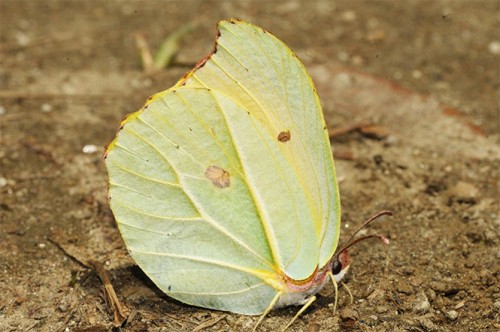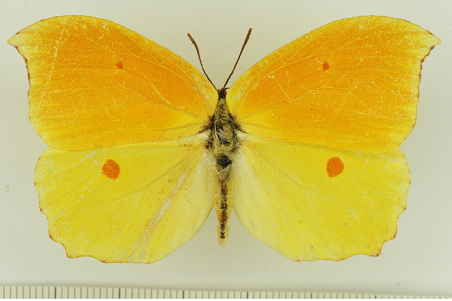RARE SPECIES SIGHTING: Viewing a group of butterflies fluttering by is always a pleasurable sight. However, the joy of naturalists Sanjoy Sondhi and Purnendu Roy doubled when they discovered not any other butterfly but a rare sub-species, the Tibetan Brimstone at Eaglenest Wildlife Sanctuary in West Kameng district of Arunachal Pradesh. The Tibetan Brimstone has been spotted in the Indian sub-continent for the first time and only the second time in the world.

Though the species was seen by the duo last April, the announcement was made in August this year after the report was published by the Journal of Threatened Taxa, an international peer-reviewed publication.
The only other time this rare butterfly was ever sighted was when it was discovered 74 years ago by British naturalist Frank Ludlow at Lalung, Pachakshiri in Chinese occupied Tibet. In 1968, Yuri Nekrutenko, a Russian lepidopterist, based on Ludlow’s butterfly collection, explained this butterfly to be a new subspecies, and named it Gonepteryx amintha thibetana.
“Ludlow collected the butterfly at Lalung in Pachakshiri in 1938,” Sondhi, who runs a non-profit organisation, Titli Trust, in Dehradun, said. “In 1968, Yuri Nekrutenko, a Russian lepidopterist, based on Ludlow’s butterfly collection, said it was a new subspecies Gonepteryx amintha thibetana.”
According to Sondhi, the butterfly was seen by Purnendu Roy who lives in London, at Anini in Upper Dirang Valley District of Arunachal Pradesh in July 1987. However, this was never reported, he said.
Rare Beauty
Tibetan Brimstone (Gonepteryx amintha thibetana nekrutenko), is pale yellowish green in colour and appears like a leaf. This illusion is enhanced by the vein-like ridges visible along its sail-shaped body.
The male butterfly has bright orange-yellow fore-wings and uniform yellow hind-wings with a small orange spot and a large orange spot respectively. The underside of fore wing and hind wing is greenish-white with brown spots; that on fore wing small, and on hind wing, large.
The female of the species is greenish-white above and below; its wing shape and disco cellular spots similar to the male.
Yet another species of butterfly, the Bhutan Glory, discovered by Ludlow had also been sighted at Eaglenest and Dirang in West Kameng district, in 2012. It is the national butterfly of Bhutan and was earlier known to exist at only one location in the same country.
“The sighting at Eaglenest busted the myth that Ludlow’s Bhutan Glory exists only in the country after which it is named,” Sondhi says.
Flyer’s Paradise
He adds that while the Tibetan Brimstone was first supposed to have been seen at Pachakshiri, that region is actually in West Siang district of Arunachal Pradesh. Hence the effort to have the geographical location of the species recognised was also important.
“Arunachal, especially Eaglenest, is a rich biodiversity zone and probably many more species of butterflies and birds are waiting to be discovered there,” Sondhi said.
Eaglenest is no stranger to such sightings. The Bompu Litter Frog, a new frog species with blue eyes, was also discovered at the sanctuary in 2011.
The sanctuary spreads over an altitude range of 500m to 3000m with ridges, streams and waterfalls. This is ideal for a variety of birds to thrive of varying hues at progressive heights. Eaglenest is a haven for about 165 species of butterflies, 450 species of birds and 15 species of mammals.
Yet another unique feature of this sanctuary is its community-based ecotourism initiative managed by the Bugun tribe. This effort benefits both the tribe and the preservation of the bird diversity.
“These new discoveries also highlight the unique, unexplored bio-diversity of Arunachal Pradesh and the urgent need to protect the forests, which are the homes for these wild creatures,” commented Arunachal Pradesh Chief Wildlife Warden and PCCF (Wildlife and Biodiversity) N N Zhasa.
The sanctuary will host its first bird festival early next year, supported by the Arunachal Government and the BWS(The Bugun Welfare Society).
More Related Stories,
Vanishing Butterflies could mean a Vanishing Planet
Receding habitat Threatening Ganga River Dolphins
How Children can get Close to nature
Reference Image courtesy Male holotype image and reference










Why, it looks just like a leaf standing upright! Beautiful creatures of God, aren’t they all?
Absolutely! It is amazing how scientists could identify this particular species and prove that it is found in India too. Considering, a butterfly’s lifespan is just about 1 week, that is a wonderful feat.
I agree that they are beautiful creatures of God — which is a good reason not to “collect” them as scientists tend to do. “Collecting” means killing. It isn’t necessary to kill wildlife in order to study it. And destroying every beautiful creature is a bad idea. I feel it’s time to oppose the practice of “collecting scientific specimens” and call it for what it is — killing.
Well said. I agree completely.
I think i have seen the same butterfly in 2003. Even have photographs of it.
That is interesting. If you can share the photo with us, we might be able to send it to experts for verifying. Reach us at contact@indiasendangered.com